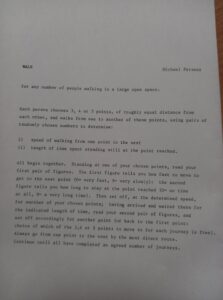Play Matters, Miguel Sicart, offers a theory of play that is all-encompassing and boundless; a form of engagement or participation within the world and with one another. He alludes to play as being amid ‘order and chaos’, (pg 3) not one or the other; an active, organic permanence within all actions and ventures. play lies on the ‘verge of destruction’ (pg 3) where expressiveness and freedom are to be found, an estrangement from inhibition and regulation. ‘Like any other form of being, play can be dangerous; it can be hurting, damaging, antisocial, corrupting’ (pg 2), distancing itself from ‘playful’ and ‘fun’, play is proposed as ‘a way of being in the world’ with its own choices and agency.
‘We need play precisely because we need occasional freedom and distance from our conventional understanding of the moral fabric of society. Play is important because we need to see values and practice them and challenge them so they become more than mindless habits.’
play is outlined here as an approach or way of accessing an alternative way of being, one where we can see, play with and rearrange the rules and customs that surround us. play is a way of ‘expressing ourselves’ and learning and adapting, to and from, ‘what makes us human.’ how this happens is complicated with an intricate web of variables; the context of a ‘game’ and its agency, the players, objects being interacted with and ‘rules, negotiations, and locations.’ how do we know when we have stepped into play? when these new rules and ways of interacting have to be negotiated and set out? this introduces questions of how fluid a process of starting play is and to what extent it is ‘designed’.
‘It is not designed exclusively in the Bauhaus-inspired tradition of a creator who shapes an object for a function, but in a weaker sense: designed as mediated by things’
these are designed and facilitated for the ability to change over time and remain unfixed for all variables and players involved. sets of ‘rules’ can change over a period of time with fashions, as play is deemed important now within gallery spaces, is this way of participating a permanent fixture to galleries and museums?
SCORE

as a group, we followed this ‘score’ and commented about it against the A Summary of the Characteristics of Scores, Anna, Lawrence Halprin. when we thought we understood the task we began. We had to work out issues along the way- how to assign numbers, how many and what length of time is short/long. Finding an end point= was the walk something we collectively made or would there be a ‘winner’? We laughed a lot as it felt strange to be a part of a group but everyone is standing far away from one another. As the times of walking a staying in an area is different, there was time to watch one another to see what they were doing. Did this fit with individual ideas of time and distance? Why was this so funny? If completed many times it may become more of a deliberate act? We focused on an ‘equality’ within the score due to randomness of numbers but also a 0-9 way of calculating speed and time is subjective, we changed this through the process of completing the score to see if would form a different response. With added clarity we felt more comfortable as a group to do our own ‘task’ of getting from one point to another with added ‘rules’. when talking through the score we thought about ‘what-ifs’ like if there was a winner or if there was a visual aid to the score to show the movements and paths created by its players.

Leave a Reply